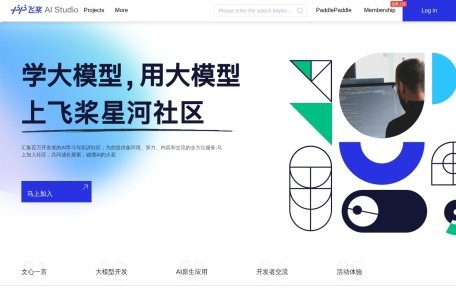
“Spent 3 days setting up a local environment only to get errors? Can’t afford an expensive GPU?” These are the two biggest headaches for AI beginners. As the core development community under Baidu PaddlePaddle, PaddlePaddle AI Studio has undergone a major upgrade in 2025: a redesigned homepage, a new Model Playground, 200+ additional open-source large models, 600+ new datasets, and it still offers 8 hours of free V100 GPU access daily. As of September 2025, the platform has gathered over 4 million developers and supported events like the Baidu Commercial AI Innovation Competition, attracting more than 2,000 participants. This article, using the latest features and real-world cases, will teach you how to master this “all-in-one AI development workstation” from scratch.
I. 2025 Core Upgrades: 3 Features Solving Key Development Pains
PaddlePaddle AI Studio centers on “computing power + resources + tools.” Its 2025 upgrades focus on resolving “difficulty starting out, confusing model selection, and complicated deployment”:
1. Redesigned Homepage: Master Core Functions in 10 Minutes
The user journey has been optimized for beginners, with key upgrades including:
- First-Level Navigation Integration: High-frequency functions like “Create Project,” “Learn Courses,” and “Find Datasets” have been moved from third-level tabs to the homepage navigation, increasing search efficiency by 60%;
- Get Started Guide Cards: Categorized into three scenarios—“Zero-Basis Introduction,” “Large Model Fine-Tuning,” and “Competition Preparation”—clicking a card gives direct access to matching tutorials and templates, eliminating aimless exploration for new users;
- Resource Recommendation Algorithm: Push relevant content based on browsing history. For example, after viewing an “image classification” course, it automatically recommends the CIFAR10 dataset and ResNet model template.
A developer shared: “Used to take 3 clicks to find datasets; now I can filter them directly on the homepage—it saves so much time.”
2. Model Playground: No-Code Testing for ERNIE 4.5
The new Playground feature acts as a “booster” for large model development, with highlights including:
- Real-Time Multi-Model Comparison: Support loading over 200 open-source models (e.g., ERNIE 4.5, Llama 3, Qwen 1.5) simultaneously. Input the same prompt to visually compare output quality, adapting to different business needs;
- Visual Parameter Tuning: Adjust parameters like “temperature” and “max generation length” via sliders—no coding required. Preview results in real time, tripling tuning efficiency;
- One-Click Deployment Connection: Export optimized model configurations as deployment code directly, supporting the FastDeploy toolkit for quick integration into web pages, mini-programs, and other terminals.
For sentiment analysis tasks, developers can test how different models recognize the sentiment of “This phone’s battery life exceeds expectations” in the Playground, then export the best model code to Notebooks for further training.
3. Expanded Resource Library: Covering All-Scenario Development Needs
In 2025, the platform’s resources have grown exponentially, forming a complete “data-algorithm-project” ecosystem:
- 600+ New Datasets: Launched a medical corpus in collaboration with People’s Daily Health Client, and a reasoning dataset with the Beijing Academy of Artificial Intelligence (BAAI)—supporting cutting-edge tasks like large model fine-tuning and human preference alignment;
- 1,000+ Open-Source Models: The full ERNIE 4.5 series is now open-source, covering NLP, multimodality, and other fields. It’s compatible with the PyTorch ecosystem, reducing migration costs for existing projects by 80%;
- 100+ New Practical Projects: Added cases like “Lawyer Avatar Agent” and “ERNIE Sentiment Analysis Tutorial,” with full code comments and video explanations.
II. Practical Cases: A Growth Path From Beginner to Competition Winner
1. Zero-Basis Introduction: Train Your First Image Classification Model in 1 Hour
With the platform’s pre-installed environment and templates, beginners can complete hands-on practice quickly:
- Register & Log In: Sign in with a Baidu account at https://aistudio.baidu.com/; complete identity verification to claim free GPU quota;
- Create a Project: Click “Projects → Create Project,” select “Notebook Project,” and configure the PaddlePaddle 2.5.1 environment with a V100 GPU;
- Verify the Environment: Run the following code to check configurations (GPU is 12x faster than CPU in tests):
import paddle
print(f"PaddlePaddle Version: {paddle.\_\_version\_\_}")
print(f"GPU Available: {paddle.is\_compiled\_with\_cuda()}")
- Train the Model: Use the pre-installed CIFAR10 dataset and ResNet model. Complete basic training in 1 hour—the platform generates accuracy curves automatically.
A college student feedback: “I got image recognition working on AI Studio on my first try—saved a full day compared to setting up a local environment.”
2. Competition Advancement: LIC 2025 Medical Track Practice
A team leveraged the platform’s resources to achieve breakthroughs in the 2025 Language and Intelligence Competition (LIC):
- Data Support: Used the platform’s new medical dataset (with 50,000 annotated medical records), skipping data crawling and cleaning;
- Model Selection: Compared ERNIE 4.0 and DeepSeek-Med in the Playground, ultimately choosing the latter for better medical scenario adaptation;
- Computing Power Guarantee: Competition-exclusive GPU quota increased to 16 hours daily. Completed 5 rounds of model fine-tuning in 3 days and won third place.
III. Must-Know for Developers: 3 Core Advantages
1. Near-Zero Computing Power Costs
- Free Resources: 8 hours of free V100 GPU access daily (worth ~¥200/day) and 100GB of storage—meeting 90% of basic development needs;
- Advanced Support: Students can apply for extra computing power after verification; enterprise users enjoy flexible pricing—90% lower cost than building a private server.
2. Uninterrupted End-to-End Development
A complete workflow from data acquisition to deployment:
graph LR
A[Dataset Search] --> B[Notebook Coding & Training]
B --> C[Model Playground Tuning]
C --> D[FastDeploy Deployment]
D --> E[Community Sharing & Iteration]
Every step is supported by built-in tools—no need to switch platforms.
3. Full-Support Community Ecosystem
- Technical Support: 150 city-based “PaddlePaddle Pioneer Groups” and official QQ groups offer real-time Q&A, with an average response time under 1 hour;
- Collaboration Tools: One-click project sharing to GitHub; contribute code via Pull Requests (PRs); join PPSIG (PaddlePaddle Special Interest Groups) for open-source collaboration;
- Growth Path: Progress from “PaddlePaddle Academy” basic courses to “Fine-Tuning Bootcamps,” with connections to competition opportunities and corporate recruitment channels.
IV. 2025 Usage Guide: Optimal Configurations for Different Scenarios
| User Type | Core Need | Recommended Feature Combination | Getting Started Action |
|---|---|---|---|
| Zero-Basis Learners | Quick AI development entry | Get Started Guide Cards + Intro Courses + Free GPU | Run “Environment Check” code → Train MNIST model |
| Advanced Developers | Large model fine-tuning & deployment | Model Playground + ERNIE 4.5 + FastDeploy Projects | Tune parameters in Playground → Export code → Deploy to web |
| Competition/Research Users | Efficient iteration & resource access | Vertical Datasets + Competition-Exclusive GPU + Community Collaboration | Download medical dataset → Team development → Submit results |
| Enterprise Developers | Fast business deployment | Open-Source Model Library + Custom GPU + Technical Support | Test model selection → Fine-tune → Deploy online |
Conclusion: The “Zero-Threshold Launchpad” for AI Development
PaddlePaddle AI Studio’s core value lies in breaking hardware barriers with free computing power, lowering technical thresholds with integrated tools, and accelerating growth via an open ecosystem. The 2025 additions of the Model Playground and expanded resource library have reduced the “idea-to-deployment” cycle from weeks to days. Currently, registration for LIC 2025 is still open (check the platform’s Competition section), and free GPU quota resets daily. Start with the “Environment Check” code—after all, true technical entry should never be blocked by hardware or configuration hurdles.
Relevant Navigation


Jiaotu AI

NewDify

Alibaba Cloud Model Studio

MGX(MetaGPT-X)

NewCREAO

SiliconFlow

Coze

